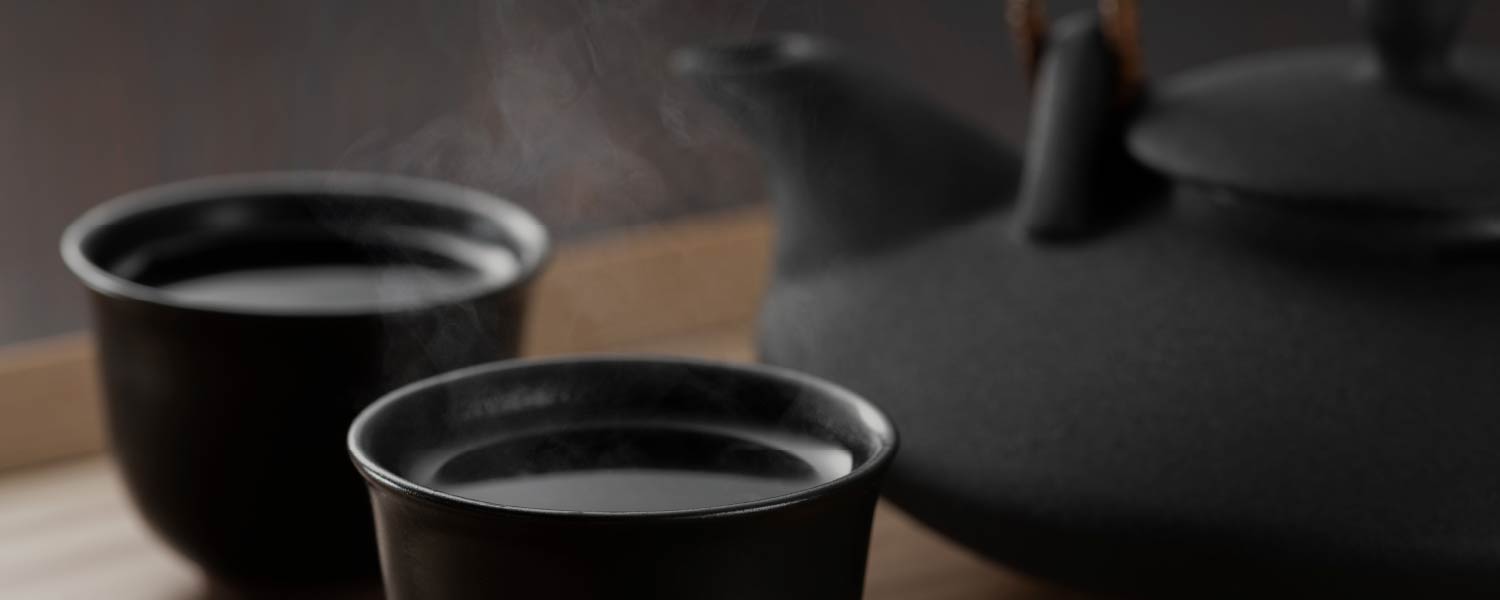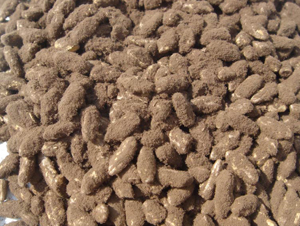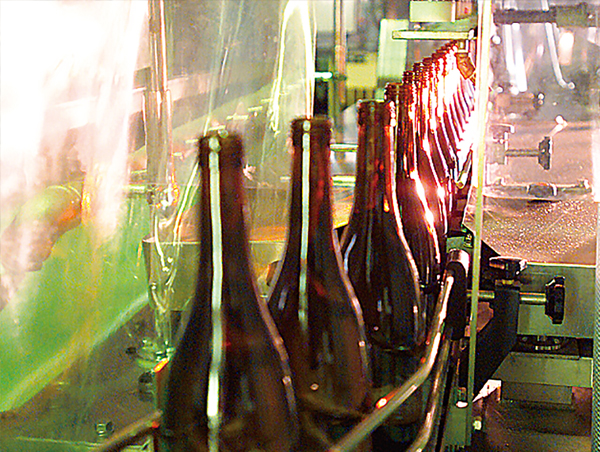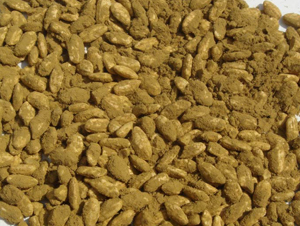Water added to shochu before bottling to adjust the alcohol content to around 20-25%. JPN: 割水 (warimizu)
Japan Sake and Shochu Makers Association | JSS


Water added to shochu before bottling to adjust the alcohol content to around 20-25%. JPN: 割水 (warimizu)
The percentage of alcohol content in shochu by volume. Another industry term for this percentage is ABV (Alcohol by Volume). JPN: アルコール度数 (arukoru dosu)
A complex aroma of aged shochu. JPN: 熟成香 (jukusei-ko)
Distillation under normal atmospheric pressure. Atmospheric pressure distillation tends to make shochu with a rich flavor. JPN: 常圧蒸留 (joatsu jyoryu)
A type of shochu brewed from black koji made from indica rice and distilled in a pot still. It originated in Okinawa, which is still the largest producing region today. JPN: 泡盛 (awamori)
Barley is one of the base ingredients of shochu and koji. Brewers polish, wash, and steam it prior to making barley koji or a barley-based mash. JPN: 麦 (mugi)

A type of koji mold that has a black appearance. It was popular in awamori making in Okinawa before expanding into general shochu making. It is capable of producing citric acid. JPN: 黒麹菌 (kuro koji kin)
Mixing different types of shochu in order to create a desired taste profile. JPN: 調合 (chogo), ブレンド (burendo)

The process of filling bottles with finished shochu prior to shipping. JPN: 瓶詰め (binzume)
Brown sugar is one of the base ingredients of shochu. It is a product of sugarcane. Brown sugar shochu is a special type of shochu exclusive to the Amami Islands. JPN: 黒糖 (kokuto)
Buckwheat is one of the base ingredients of shochu and occasionally koji. JPN: 蕎麦 (soba)
An unpleasant burnt smell that comes from the bottom of the still pot. JPN: 焦臭 (koge-shu)
A wooden container that is used for storing shochu. It adds a wooden note to the flavor and aroma of the drink. Also called a barrel. The process of aging in a cask or a barrel is called cask-aging and barrel-aging, respectively. JPN: 樽 (taru), 樽貯蔵 (taru-chozo)
A filtration process that occurs after distillation using charcoal as the filtering agent. JPN: 炭素濾過 (tanso-roka)
A filtration method conducted under low temperature that removes fatty acids and esters in order to prevent murkiness in the final product. JPN: 冷却ろ過 (reikyaku roka)
The part of a distillation device where vaporized compounds cool down and turn into liquid. JPN: 冷却機 (reikyaku-ki)
A distillation method that facilitates continuous distillation in order to extract highly concentrated alcohol. Also called column distillation. JPN: 連続蒸留 (renzoku joryu)
A type of distillation device that carries out a continuous distillation. It is the preferred still in making ko-rui shochu, vodka, and gin. Also called a column still. JPN: 連続式蒸留機 (renzokushiki joryu-ki)
Enzymes that break down starch into sugar. Koji mold produces diastatic enzymes such as amylase, making it suitable for starting the saccharification process. JPN: 糖化酵素 (toka koso)
The liquid collected from the still. Also called spirit or outflowing distillate. The first portion: foreshots, head, or hanadare. The middle portion: middle cut, heart, nakadare. Latter portion: tail, feint, suedare. JPN: 留液 (ryueki), 初留 (shoryu), はなダレ (hanadare), 中留 (churyu), 中ダレ (nakadare), 後留 (koryu), 末ダレ(suedare)
A process to extract alcohol and aromatic compounds by heating the fermented mash in a still. In shochu, most distillation uses a pot still. Distillation can occur under atmospheric pressure or reduced pressure. JPN: 蒸留 (joryu)
Traditional clay vessels in awamori production that housed the fermenting mash and aging distillate. Today, it is mainly used for aging. JPN: 甕 (kame)
A tank used to ferment the second moromi. Usually made of stainless steel. Traditional vessels for fermenting the second moromi are earthenware pots and wooden pails. JPN: 発酵タンク (hakko tanku)
A process after distillation to remove solids and excess flavor from the distillate. JPN: 濾過 (roka)
The first stage mash made of koji, water, and yeast. The purpose of making the first moromi is to cultivate a sufficient amount of active yeast. Also called starter culture or fermentation starter. JPN: 一次もろみ (ichiji moromi)
A flower-like aroma of shochu. It mainly results from the process of reduced pressure distillation. JPN: 花様 (hana-yo)
A fruit-like aroma of shochu. It mainly results from the process of reduced pressure distillation. JPN: 果実様 (kajitsu-yo)
A rice or barley-like aroma found in rice shochu, barley shochu, and awamori. JPN: 穀類様 (kokurui-yo)
A type of shochu that undergoes distillation in a pot still and retains the distinct flavor of its base ingredient. JPN: 本格焼酎 (honkaku shochu)
A nationwide annual event for evaluating the quality of honkaku shochu and awamori. JPN: 本格焼酎・泡盛鑑評会 (honkaku-shochu awamori kampyokai )
Koji is koji mold cultured on rice, barley, etc. It is an essential ingredient for shochu, as well as for sake, miso, and soy sauce. JPN: 麹 (koji)
A semi-automatic koji making machine that washes, steams, and performs the first half of koji making. JPN: 製麴機 (seikiku-ki)
The process of making and propagating koji. Steps include sprinkling koji mold spores over a sufficiently cooled steamed base and cultivating for about 40 hours. JPN: 製麴 (seikiku)
A type of mold used in shochu making. Varieties include yellow koji mold (Aspergillus oryzae), black koji mold (Aspergillus luchuensis), and white koji mold (Aspergillus luchuensismut. Kawachii). The black and white varieties produce citric acid. JPN: 麹菌 (koji kin)
The percentage of koji ingredient to non-koji ingredient by weight. JPN: 麹歩合 (koji buai)
A room dedicated to making koji. In shochu production, sometimes an automated machine handles koji making instead. JPN: 麹室 (koji muro)
Spores of the koji mold. It is sprinkled over cooled steamed ingredients to make koji. JPN: 種麹 (tane koji)
A traditional steamer used to steam the base ingredients. JPN: 甑 (koshiki)
Kusu is awamori that is aged for over 3 years. It has high value in Okinawa. Kusu has a rich flavor and vanilla-like sweet aroma. JPN: 古酒 (kuusu)
The aroma of shochu left in sunlight. JPN: 日光臭 (nikko-shu)
Loss of shochu during production or aging processes. JPN: 欠減 (ketsugen)
The part of the still that connects the swan neck and the condenser. Also called a lyne pipe. JPN: ワタリ (watari)
Most shochu are aged up to a year before shipping. Thanks to koji, shochu has a relatively smooth taste from shortly after distillation, but some products are aged for over 3 years. The aging process makes shochu extra smooth, and creates new flavors, making it richer in taste as well. JPN: 熟成 (jukusei)
A byproduct of sugarcane during the sugar making process. It is a base ingredient in rum, but not in shochu. JPN: 糖蜜 (tomitsu)
Process wherein saccharification and fermentation occur simultaneously. JPN: 並行複発酵 (heiko-fukuhakko)
Unaged bottling of the first run of the season. Also called new pot. JPN: 新酒 (shinshu)
In shochu production, the term “oily component” refers to both the fatty acids and the fatty acid ethyl ester, which is a combination of fatty acid and alcohol. They may solidify and result in a murky appearance under a low temperature. However, this effect is harmless and the murkiness usually disappears after an increase in temperature. JPN: 油性物質 (yusei-busshitsu)
The process of polishing the outer layers of rice and barley before being used for koji making and the mash. JPN: 精米 (seimai/polished rice), 精麦 (seibaku/polished barley)
The part of a distillation device (still) where the substance to be distilled is placed. JPN: 蒸留缶 (joryu-kan )
Traditional method of distillation that uses a pot still. It is also called batch distillation. JPN: 単式蒸留 (tanshiki joryu)
A traditional type of distillation device that carries out a single distillation. It is used for all shochu, whiskey, and rum. JPN: 単式蒸留機 (tanshiki joryu-ki)
A prickly aroma or mouthfeel. Fresh shochu can be slightly pungent. JPN: 刺激臭 (shigeki-shu)
Rice is one of the base ingredients of shochu and koji. It is polished, washed, and steamed prior to use in koji making and in the mash. JPN: 米 (kome)
A pleasant aroma often found in shochu distilled under atmospheric pressure. It is also characteristic of aged shochu. JPN: 香ばしい (koubashi)
A process of breaking down starch into sugar. In shochu making, koji enzymes enable saccharification. JPN: 糖化 (toka)
Sake lees is one of the base ingredients of shochu. It is a byproduct of sake and is refermented before distillation. JPN: 酒粕 (sake kasu)
The mash made of water, the base ingredients and the first moromi. This is where the main fermentation occurs. Also called main moromi, fermenting mash, and main fermentation. JPN: 二次もろみ (niji moromi)
Shochu is a distilled alcoholic beverage indigenous to Japan. Shochu can be divided into “honkaku shochu” and “ko-rui shochu”, but on this website, “shochu” refers to “honkaku shochu” only. Several ingredients can serve as the base for shochu, including sweet potatoes, barley, and rice. It usually undergoes distillation once in a pot still. JPN: 焼酎 (shochu)
A producer of shochu. They are located across Japan, but most are in Kyushu and Okinawa. JPN: 蔵元 (kuramoto)
The solid byproduct of shochu making that remains in the still after distillation. It can be used as cattle feed. Also called spirit stillage. JPN: 蒸留粕 (joryu-kasu)
The removal of oily components from the surface of shochu to prevent an oily odor. JPN: 油の掬い取り (abura no sukuitori)
The part of a distillation device where the outflowing distillates are monitored for the cut point, strength, and temperature prior to delivery to the relevant receivers. Also called hydrometer jar. JPN: メートルボックス (metoru-bokkusu)
The part of a distillation device where the distillate collects. Also called spirits receiver. JPN: 製品タンク (seihin-tank), 検定タンク (kentei-tank)
Spoilage of the moromi caused by microbial contamination. JPN: 腐造 (fuzo)
The process of steaming the base ingredients before use in koji making or the mash. JPN: 蒸し (mushi)
A traditional steamer to distill sake lees to make shochu. Usually, sake lees is mixed with rice husks and placed on a basket inside the steamer. When it is steamed, alcohol in the sake lees is vaporized, which is condensed and collected. Also called bamboo steamer. JPN: 蒸籠式蒸留機 (seiroshiki joryu-ki)
After polishing and washing, rice is soaked in water to adjust the water content prior to steaming. JPN: 浸漬 (shinseki)
Shochu is generally stored in earthenware pots or tanks. Occasionally it is stored in wooden casks as well. JP: 貯蔵 (chozo)
A style of serving shochu without the addition of other mixers or ice. Also called neat. JPN: ストレート ( sutoreto)
The part of the still that stretches out of the pot and curves like a swan’s neck. It connects to the condenser via the lyne arm. JPN: 濃縮塔 (noshuku-to)
Sweet potato is one of the base ingredients of shochu and occasionally a base ingredient of koji. The edges are trimmed, washed, and steamed for use in the mash. There are yellow, white, orange, and purple varieties of sweet potatoes. JPN: 芋 (imo) or サツマイモ (satsuma imo)
The head of all the shochu makers in a distillery. They direct and manage overall shochu making. JPN: 杜氏 (toji)
A semi-automatic koji maker used in the second half of koji making. JPN: 三角棚 (sankaku dana)
Two-row barley is a strain of barley. It is the main barley variety used in barley shochu. It has large kernels containing a high concentration of starch. JPN: 二条大麦 (nijo omugi)
Shochu that was not diluted with water to adjust the alcohol content before bottling. It usually contains around 35% alcohol. JPN: 原酒 (genshu)
Shochu bottled without undergoing filtration. JPN: 無濾過 (muroka)
Distillation under a lower pressure than the atmospheric pressure. It tends to make a light flavored shochu with floral and fruity aromatic notes. Also called reduced pressure distillation. JPN: 減圧蒸留 (genatsu joryu)
A vanilla-like aroma often found in aged awamori. JPN: バニラ香 (banira-ko)
Shochu making requires a lot of water to wash and steam the ingredients, make the mash, and dilute the distillate. JPN: 仕込み水 (shikomi mizu)

A type of koji mold that has a white appearance. It is a mutant variety of the black koji mold, discovered in 1918. It is capable of producing citric acid. It is the most widely used koji mold in shochu production today. JPN: 白麹菌 (shiro koji kin)
A style of serving shochu mixed with hot water. JPN: お湯割り (oyuwari)
A style of serving shochu mixed with carbonated water. JPN: ソーダ割り (sodawari)
A style of serving shochu mixed with cold water. JPN: 水割り (mizuwari)
Yeast converts sugar into alcohol and carbon dioxide gas. Shochu yeast must survive both warm temperatures and a highly acidic environment. Prefectural research institutes and the Brewing Society of Japan distribute yeast to shochu distilleries. JPN: 焼酎酵母 (shochu kobo)

A type of koji mold that has a yellow appearance. It is popular in sake making and also popular in shochu making until the early 1900s. It cannot produce citric acid and largely fell out of practice behind black and white koji molds. JPN: 黄麹菌 (ki koji kin)